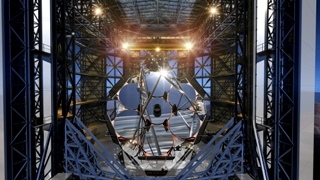Jun 4 2015
The Giant Magellan Telescope Organization has announced today that its 11 international partners have committed more than US$500 million to begin construction of the first of a new generation of extremely large telescopes. Once it is built, the Giant Magellan Telescope is poised to be the largest optical telescope in the world.
 Concept image of the Giant Magellan Telescope (Photo: Business Wire)
Concept image of the Giant Magellan Telescope (Photo: Business Wire)
The Giant Magellan Telescope’s seven mirrors span 25 meters and will focus more than six times the amount of light of the current largest optical telescopes into images up to 10 times sharper than those of the Hubble Space Telescope. The GMT will enable astronomers to look deeper into space and further back in time than ever before. The telescope is expected to see first light in 2021 and be fully operational by 2024.
“The GMT will herald the beginning of a new era in astronomy. It will reveal the first objects to emit light in the universe, explore the mysteries of dark energy and dark matter, and identify potentially habitable planets in the Earth’s galactic neighborhood,” said Wendy Freedman, chair of the Giant Magellan Telescope Organization (GMTO) Board of Directors and University Professor of Astronomy & Astrophysics at the University of Chicago. “The decision by the GMTO partner institutions to start construction is a crucial milestone on our journey to making these amazing discoveries using state-of-the-art science, technology and engineering.”
GMTO President Edward Moses said, “The GMT is a global scientific collaboration, with institutional partners in Australia, Brazil, Korea, the United States, and in host nation Chile. The construction approval means work will begin on the telescope’s core structure and the scientific instruments that lie at the heart of this US$1 billion project. Early preparation for construction has included groundwork at the mountaintop site at Las Campanas in northern Chile, and initial fabrication of the telescope’s seven enormous primary mirror segments.”
Professor Matthew Colless, Vice Chair of the Board of Directors and Director of the Research School of Astronomy and Astrophysics at The Australian National University, said the construction approval was an exciting moment for astronomy.
“Plans that have existed only in two dimensions or as computer models are about to become a three-dimensional reality in glass, steel, and high-tech semiconductor and composite materials,” said Colless. “The Giant Magellan Telescope will provide astronomers and astrophysicists with the opportunity to truly transform our view of the universe and our place within it.”